Henri Matisse wrote that he dreamed of an art without troubling or depressing subject matter, “like a good armchair which provides relaxation from physical fatigue.” I had that thought last week when ducking inside Sargent’s Daughters modernist space to escape the Siberian blast troubling New York City. In “Ross Bleckner and Volker Eichelman,” the gallery has mounted an involving show of 27 Bleckner paintings, 18-inch-square outtakes from the past 20 years of his extensive career.
.
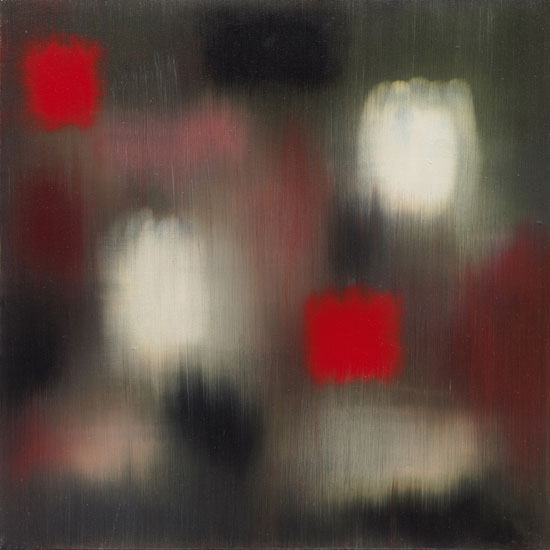
"Untitled" by Ross Bleckner, 2002. Oil on linen, 18 x 18 inches.
.
The paintings typically correspond to the themes and groups of Bleckner’s oeuvre, such as his Lifespan Paintings or his Forgetting Paintings, also some from his recent Black Monet Paintings and others based upon the AIDS crisis, which he denoted Molecule, Blood and Disease works.
Most of the work is painted in subdued tones in various sub-schools of abstract expressionism, art without an overt subject but immediate with emotion similar to classical music performed without singers. There is an occasional splash of color to enhance its esthetic and many works feature his signature fuzzy dots or spots that hover above the canvas like lilies on a pond.
.
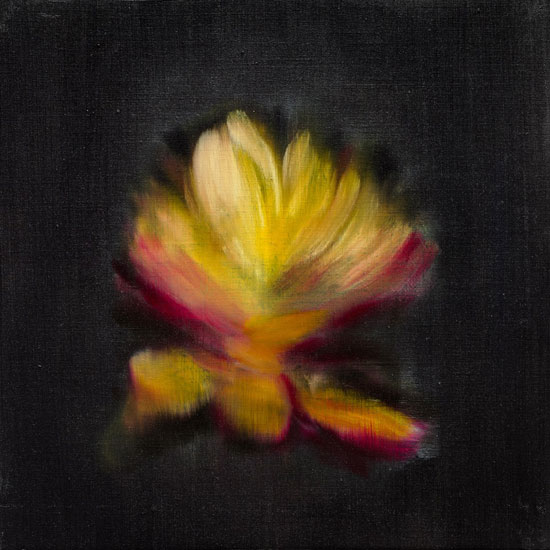
"Untitled" by Ross Bleckner, 2014. Oil on canvas, 18 x 18 inches.
.
Bleckner chose the 18-inches-a-side format for these studies and miniatures because the number figures prominently in Jewish culture: the letters of the symbol chai, meaning “life” or “light,” add up to 18. Thus this number signifies spirituality, and in contemporary Judaism, monetary gifts are often in denominations that are a multiple of 18. Bleckner draws on this historical numerology to help activate his abstract paintings, one more example of why he often sets his critics’ hair on fire.
Bleckner, now 65, has painted since the early 1970s, surviving a remarkable set of critical hegemonies that sought to punish painters with spiritual content, using everything from Marxism to deconstruction theory to accomplish the task.
.
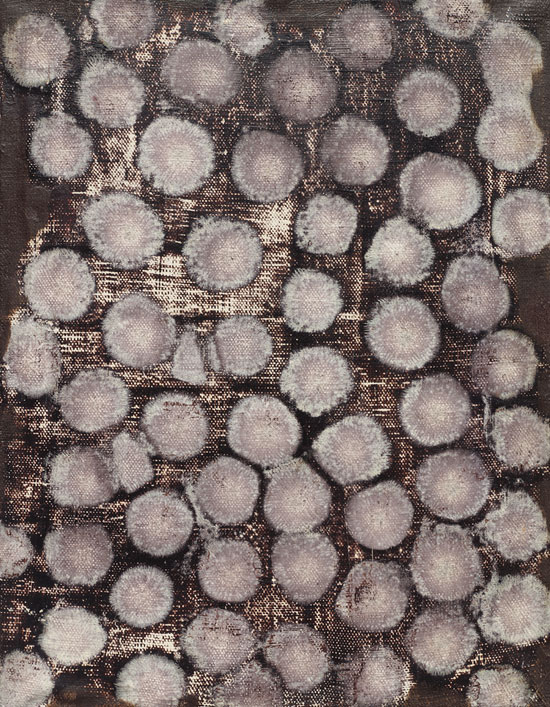
"Untitled" by Ross Bleckner, 1991. Oil on linen, 18 x 12 inches.
.
He started his career during the wane of Marxist-inspired Clement Greenberg, a one-person critical institution who was a promoter of various forms of abstract painting, especially those that had little to do with the artist who was doing the actual painting. Greenberg favored, sequentially, Abstract Expressionism, then Color Field painting, and later Lyrical Abstraction.
All three were overturned as a serious enterprise by a new generation that fancied Pop Art and Post-Modernism irony, which later degraded into Jeff Koons’s Post-Criticality and, with a surprise resurgence of Modernist styles, what Walter Robinson has nailed as “Zombie Formalism.”
Translated into English shorthand these critical movements might be recast as: Here. Everywhere. Ooh. Already there. No way. Who cares? What, again?
In addition to the critical sniffing at his spiritual overtones, Bleckner came of age at a time when being mentioned in the press as a young artist was suspect, and he was always in the press. The NY Times catcalled that he made the society pages as often as sandalista Bianca Jagger. The Daily News described his 1995 Guggenheim survey as the “artist who paints the town red.” Red for rage, of course.
Bleckner never shied away from publicity; he even purchased the five-acre Sagaponack estate previously owned by the ultimate social gadfly Truman Capote. Which is all a long way of saying he has often had a rough time with the critics. But now back to the armchairs.
Sargent's Daughters gallery opened in late 2013 on New York's Lower East Side. The focus here is on contemporary art that has a “strong historical lineage while challenging current aesthetic conventions”; the cool name is a reference to 19th century American painter John Singer Sargent. With a good space and a smart program, the art world is expecting big things from this enterprise.
The gallery produced a catalog for the show without the de rigueur leaden essay, or such basics as painting titles, dates, or even descriptions … just beautiful paintings. This novel idea makes seeing the show somewhat like viewing a catalog in a language one does not speak, so the images carry the burden of being persuasive without the costume of words normally included.
.
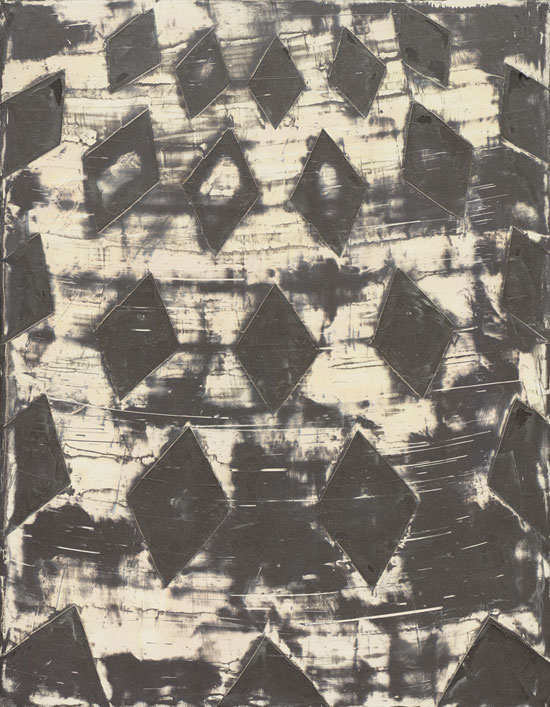
"Untitled" by Ross Bleckner, 1992. Oil on linen, 18 x 12 inches.
.
The same is true for the show itself, which has no wall labels. The paintings are untitled and done over a couple of decades; I doubt Bleckner even knows when they were done, although the checklist provides a general idea.
On the catalog cover is a large script “18,” keeping with the spiritual silence theme of these subdued and peaceful works. Without titles or dates it is somewhat difficult to discuss individual works, but the exhibition is certainly a pleasure to view.
.
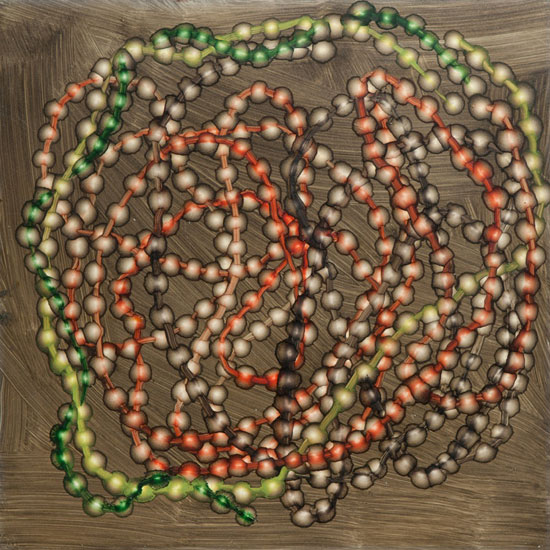
"Untitled" by Ross Bleckner, 2001. Oil on canvas, 18 x 18 inches.
.
And, at a low chai asking price of $18K, even those collectors shut out by the recent art market tsunami can own a work by an expert and accomplished artist with extensive museum credits.
Also on view in this two-person exhibition are text paintings by the German artist Volker Eichelmann based on writings by British luminaries William Beckford and Stephen Tennant.
BASIC FACTS: “Ross Bleckner and Volker Eichelmann” is on view February 11 to March 15, 2015 at Sargent's Daughters, 179 East Broadway, New York, NY 10002. www.sargentsdaughters.com.
